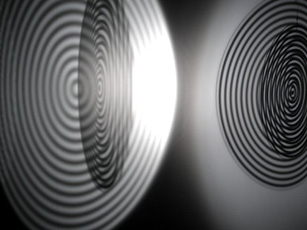|
Walking into the dimly lit circular room that formed Your negotiable panorama, you were first aware of being surrounded by a horizontal ring of white light that broke into random undulating filaments of light and shadow that danced around the wall before coalescing into a single, narrow ribbon and becoming still. A round pool of water illuminated by projected light dominated the center of the room, and just as you were beginning to make the connection between the movement of the water and the wavelike reflection on the wall, another visitor would happen to enter the room and the dance began again. It's likely that more than a few visitors did not catch the relationship between their entrance to the room (walking over a ramp that was a trigger for the water's activity) and the movement of the light, which made it even more mysterious. From there one moved on to Your uncertain museum, entering through a "hallway" formed by a spiral of stretched, translucent gray scrim. This led into a circular area occupied by four large disks that were hanging from wires and revolving lazily. A target pattern of alternating concentric mirror and translucent stripes made up the surface of the disks, and as each slowly rotated you could see the other disks both through them and in reflection. A spotlight lighted all, and if a disk happened to reflect the light your way, it was a blinding surprise. The mesmerizing turning of the disks, along with the play of pattern upon pattern, lulled you into a place where, as in a black-and-white film, you forgot about color completely until a disk would turn to unexpectedly show your own image to you in sudden, blazing Technicolor. While the piece in the large room upstairs had no kinetic aspects, it was in many ways the most spectacular. Entitled The inverted mirror sphere, it was a massive, globe-like "chandelier" suspended from the ceiling which, in a nostalgic touch, was made up of mirrored triangles similar to those Eliasson had used in a skylight piece in the same room several years ago. This time the mirrored triangles were attached to a spiral of steel tubes to form a pattern that was an elegant play on Buckminster Fuller's geodesic dome, a source for much of Eliasson's work. Illuminated from inside by a bright white light, the globe, like a brilliant ballroom disco ball, reflected a radiant geometry onto the walls, floors, and people in the room. If one of those people were to go stand under the globe, they'd find that their head fit neatly through a round hole in the bottom, containing them in a private universe of heat, light, and reflection. To experience Eliasson's final installation, one had to stumble through black drapery (a tiresome requirement of much art these days, and one Eliasson, to his credit, has most often managed to do without) into a darkened room solely occupied by a black basketball-sized half globe on the far wall on which a white arrow of light moved to point in four different directions. Going through another curtain to the side of the globe revealed that the arrows were pinhole reflections from a larger installation of neon. After the previous three situations that invited the viewer to be so keenly involved, this work, which seemed to offer little more than the illustration of a clever idea, served as an anti-climax. -Carol Diehl |
Olafur Eliasson at Tanya Bonakdar
Olafur Eliasson at Tanya Bonakdar
Art in America
December 2006
p.155
 For an artist, change and growth involves continually working against one's strengths-having the courage to abstain from the tricks that have worked in the past in order to explore fresh possibilities for resolution. In contrast to many artists who, especially as they become successful, appear unwilling to challenge themselves in this way, it seems as if Olafur Eliasson is always pulling the rug out from under himself. Having achieved international recognition with work in which color predominated—most notably The Weather Project, his 2004 installation which bathed the Turbine Hall at London's Tate Modern in an eerie yellow glow—it's significant that, in his first New York exhibition since then, he chose to work with no color at all.
For an artist, change and growth involves continually working against one's strengths-having the courage to abstain from the tricks that have worked in the past in order to explore fresh possibilities for resolution. In contrast to many artists who, especially as they become successful, appear unwilling to challenge themselves in this way, it seems as if Olafur Eliasson is always pulling the rug out from under himself. Having achieved international recognition with work in which color predominated—most notably The Weather Project, his 2004 installation which bathed the Turbine Hall at London's Tate Modern in an eerie yellow glow—it's significant that, in his first New York exhibition since then, he chose to work with no color at all.